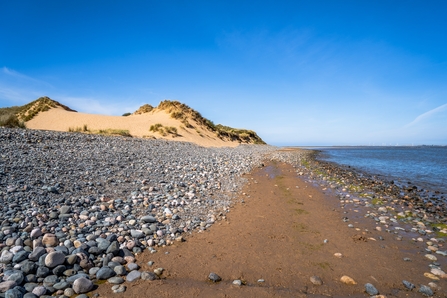
Internationally-significant nature reserve at Sandscale Haws is under threat from planning application © Michelle Crake
Gifting membership? Order by Wednesday 17 December in time for Christmas.

Internationally-significant nature reserve at Sandscale Haws is under threat from planning application © Michelle Crake
A coalition of nature and landscape charities have joined forces to object to a serious threat to the internationally significant nature reserve at Sandscale Haws and the wider Morecambe Bay and Duddon estuary.
A planning application for the Roanhead Farm redevelopment, which lies directly adjacent to the nature sites has recently been submitted by developer ILM Group for a holiday park with 450 cabins and associated leisure and retail facilities, which the application states will generate 130,000 visitors a year.
There are a range of concerns with the most critical related to the impact of the footfall and trampling of thousands of additional visitors disturbing the fragile ecosystems. The nature reserve and estuary provides a refuge to some of the rarest and most protected species in the UK.
The Sandscale Haws nature reserve is a much-loved local jewel for the residents of Barrow and Askam. Dan Taylor, the General Manager for the National Trust who look after the reserve on behalf of the nation said: “We want to ensure that local people can continue to enjoy this special place, balancing our conservation work to safeguard a very sensitive ecosystem whilst providing a warm welcome. We are concerned that the scale of this development would risk irreparable harm to the fragile wildlife habitat, and would also reduce the benefit that it provides to local communities.”
A critical part of the planning application requires the developer to demonstrate the impact its visitors would have on the adjoining nature reserve and estuary and how these will be mitigated. The Habitat Regulation Assessment chapter includes no survey work outside of the development boundary which is a significant omission. The mitigation proposals included in the application to deal with the sheer volume of additional visitors and dogs are weak and impossible to enforce.
Other serious concerns include inadequate access for the additional 943 vehicle movements a day along a very narrow country lane (Hawthwaite road), the noise, light and water pollution created by thousands of visitors, the visual impact on the landscape and the impact on the character of the area. We believe the additional visitor number of 130,000 stated in the planning application is a very low estimate based on the capacity of the proposals submitted.
To find out more about the impact of the development proposal and to make your voice heard please visit the Cumbria Wildlife Trust call to action.
The consultation closes at midnight on Sunday 23 July 2023.
Stephen Trotter, Chief Executive, Cumbria Wildlife Trust said: “Cumbria Wildlife Trust is very concerned about the proposed resort as it's immediately next to highly sensitive sand dune habitats, with rare and threatened wildlife like the biggest population of natterjack toads in Britain, otters, large numbers of threatened wading birds, unusual plants and the rare spring mining bee. The extra disturbance and pressure may put at risk much of this special wildlife and some may disappear altogether.
“We strongly support the need for economic regeneration in Barrow-in-Furness and we welcome new jobs and opportunities in the area, but it's vital that development doesn’t damage the internationally-important natural assets on which society is based. We strongly support the growth and development of sustainable tourism but in our view, this is simply the wrong location for this scale of holiday resort. It’s just too close to such an important and irreplaceable wildlife site.”
Friends of the Lake District CEO Michael Hill said: “The pressure of thousands of additional visitors to Sandscale Haws will harm not only the sensitive habitats but the unique landscape character of this area, and in turn the sense of tranquillity and escape that local people currently enjoy and benefit from. We’re standing with the local community and other concerned organisations to make clear that this is the wrong development, in the wrong place and must be stopped”
The RSPB, the UK’s largest nature conservation charity, has also raised its concerns about the development.
Robin Horner, RSPB Area Manager & Chair of the Morecambe Bay Local Nature Partnership, said, “The Duddon Estuary is internationally important for its wildlife and nature urgently needs more protection, not less. Natterjack toads, for example, are Britain’s rarest amphibian and the coastal areas that would be impacted by this development are home to a quarter of them. We have grave concerns that this development would have a detrimental effect on some of the UK’s rarest plants and birds, such as the endangered Curlew, and will work with partners to oppose it.”
James Robinson, Director of Conservation, Wildfowl & Wetlands Trust (WWT) said: "The Duddon Estuary hosts rare and much-loved bird species, such as knot, pintail and redshank making it an internationally important wetland designated under the Convention on Wetlands. We've already lost 75% of Wetlands in the UK since 1700 and we can't afford to lose any more of these habitats that are essential for people and wildlife. This development would put unacceptable pressure on the unique ecosystem that is so important to the local area.”
Dr Tony Gent, Chief Executive Officer, Amphibian Reptile Conservation said: “The natterjack toad is a charismatic and much-loved species of amphibian, but one that is declining even in its Cumbrian stronghold and that is increasingly being threatened through changing land use, climate change and sea level rise. This area is of national significance for this species, and also home to strictly protected great crested newts. The development is too big and too close to the sensitive habitats that these species depend on, and will add a huge additional visitor pressure; these proposals represent an unacceptable risk to nature”.